Jorden, Walter (McKechnie Section 3)
See also Richard Jorden
Jackson (The History of Silhouettes) records Richard and W. Jorden, stating that they were brothers. Mills records the artists as Richard and Walter Jorden. Since it is difficult to separate the available information about the lives of the Jordens, I shall discuss this, the biographical evidence provided by their work, and (for convenience) the technical and stylistic attributes which they shared in their work in the present entry on Walter Jorden (the eider of the two artists). Since, however, I consider that the extant silhouettes can confidently be ascribed to one or other of the Jordens individually, I shall only discuss in detail the work of Walter Jorden in this entry. For a corresponding account of Richard Jorden's work (and inscriptions), see the entry on him.
No advertisements or printed trade labels used by either of the Jordens have come to light, and any information about them has to be gleaned from inscriptions seen on the reverses of a few of their silhouettes. Jackson (The History of Silhouettes) illustrates six portraits of the Deverell family, dated 1783, which she ascribes to 'William Jorden', but a comparison of these with signed examples by Richard Jorden suggests that these must have been the latter's work.
1115
Since the illustrated profile of Kitty Berwick, dated 1776, must, on stylistic grounds, be considered an early example of Walter Jorden's work, he may have been the elder of the two brothers; the earliest example by Richard Jorden which is known to me (a profile on paper) dates from 1779-80. Walter appears to have remained in practice for at least ten years; one of the illustrated examples of his work is of a woman wearing an à la conseilleur hair-style, which did not come into fashion until 1786. I have seen no work by Richard Jorden dating from after 1785.
863
Three examples of work by the Jordens are illustrated by Mills: two (on glass) are ascribed to Walter; one (on paper) to Richard. The style of these pieces is similar to that of the identified profiles which I have illustrated. One of these (ascribed to Walter) is a full-length silhouette now in the Royal Collection; the sitter, originally believed to have been Queen Charlotte, is now known to have been Madame de Genlis, governess to the children of Philippe Égalité, later King of France, and his secret mistress (see Mrs Peggy Hickman, 'Silhouettes by Charles of the Strand', Country Life, 30 August 1962). Illustrations of portraits of her in Violet Wyndham's Madame de Genlis (London, 1958) confirm the identity of the sitter of this silhouette, which is also illustrated by Jackson. Whether this portrait (probably c. 1783-85) was painted from life has not been established. Violet Wyndham states that two, apparently illegitimate, daughters of Madame de Genlis were brought up in England. (Their father was an English colonel named Compton). These girls, whose names were Pamela and Hermine, were later taken to France. Some details of the current gossip about the girls were contained in a secret letter (dated 24 May 1785) written by Louis XVI. Madame de Genlis might have visited England to see her children (just as Lady Elizabeth Foster visited her children by the fifth Duke of Devonshire while they were being brought up in France), and this portrait may have been painted during one of these visits.
Jackson records six silhouettes by Walter Jorden (in her collection) of friends of the family of Lady Shaftesbury (probably Mary, the daughter of Jacob, Viscount Folkestone, who married the fourth Earl of Shaftesbury in 1759). The sitters were William Bray (1736-1832), a historian who lived in Surrey; Maria Dickons (1770-1833), a singer well known in London in her day; Frederica, Duchess of Landgrave; David Bishop; a son of the Reverend Samuel Holworthy, of Croxell, Derby; and an unknown lady. The seats of the Shaftesbury family were St Giles' House (Cranbourne, Dorset), Rose Dale House (Richmond, Surrey) and 24 Grosvenor Square, London. Presumably Walter Jorden was working near one of these houses at one period.
Many inscribed portraits show that the Jordens worked in Wales and near the Welsh border. The profile of Kitty Berwick (apparently by Walter) is inscribed `Newtown, 1776'. ,Of three glass profiles owned by Mr M. A. H. Christie, one bears an inscription by Richard Jorden at `Mrs. Walter Vaughan's, Brecknock Forum'. Another (by Walter) in the same collection, although inscribed 'Lady Salusbury Cotton' by a previous owner, appears to be of Katherine (née Vanne) of Llanwern, who married Robert Salusbury (created a baronet on 4 May 1795), of Cotton Hall, Denbigh. Another example taken near the Welsh border is the profile of Maria Elisa Cuxon, which was painted in Shifnal, before her marriage to Etienne Thibaud in c. 1785. Unfortunately no trace of Richard Jorden's stay in Brecon can now be found. Nor is there any record that he stayed in Plymouth, although the words 'of Plymouth' have been seen typed on the reverse of a silhouette in the Christie collection. (Possibly these words have been wrongly copied by a former owner from a contemporary inscription which had been damaged, and which in fact originally read 'of Monmouth').
There is no evidence that the Jordens were of Welsh origin; they may simply have chosen this area because in their day it had not yet been explored by silhouette artists.
There is a `repeat' silhouette, bearing a Miers and Field trade label, which is apparently an accurate copy, probably by John Field, of a silhouette by Walter Jorden. The sitter was the Reverend William Ellison (1755-1819), Rector of Linby Green, Durham. Unless this was taken while the sitter was on holiday in Wales, we must assume that the Jordens travelled widely in Britain.
1386
Of the illustrated examples, only one silhouette by Walter Jorden (of a Miss Peninnah Herdsfield) bears a signature; it is inscribed in pencil, `By W. Jorden'. The other examples attributed to this artist, whose work was individual in style, have been identified by comparison. Likewise, two of the illustrated examples by Richard Jorden are signed; the remainder have been identified by comparison.
The stylized and patient work of Walter Jorden suggests that painting silhouettes was probably not his main means of livelihood, which he may have derived from producing easel paintings or drawings. Richard Jorden's work, on the other hand, though sought after on account of its rarity, does not suggest an equally versatile talent.
Both the Jorden brothers painted on flat glass, and backed their work with a second piece of glass coated with gesso which gives a greenish or greyish hue to the background of the silhouette. Some surviving profiles lack the glass backing, which has either been broken or not replaced after removal before the cleaning of the profiles.
The earliest profile attributable to Walter Jorden is that of Kitty Berwick, referred to above. The sitter wears costume which one would expect at this date. Although the outline is fairly plain, the style shows features that appear on profiles painted by Jorden almost ten years later. Though, under magnification, the small strokes comprising the frill on the front of the sitter's dress appear slightly different from those on later work, the idea underlying the treatment is much the same. Also common to both this silhouette and the later examples is the series of small brush-strokes which gives a fringed effect to the bust-line termination. On the later work these strokes are finer and longer than on the profile of Kitty Berwick. The bust-line termination on this early example is similar to that of another (illustrated) which appears to have been painted c. 1784-85. The latter, however, does not show the effect of a fringe at the bust-line which is seen on the 1776 silhouette, and the laces are not shown in such profusion as on work dating from 1786-88.
Examples painted from late 1785 onwards show that Jorden had developed his style, using special `quirks' to enhance the appearance of a silhouette. One change was in the contour of the bust-line termination, which he altered to show a dip at the junction of the arm with the rest of the profile. This feature (which is sometimes partly obscured by the profusion of lace which is shown surrounding the arm) recalls the bust-line terminations of silhouettes on plaster by Thomas Patey (see Section Four). Lace is added in profusion, especially on profiles of women.
Jorden's profiles of the period c. 1784-88 were painted at a time when a handkerchief, or buffon, was worn to cover the wearer's low décolletage. Although these were often made of plain materials, such as muslin, Walter Jorden depicts them, as he also depicts trailing gauzes and the ribbons of head-dresses and hats, with an elaborate technique involving the use of multitudinous dots and zigzag lines, and patterns evolved by the obliteration of patches of dots to form plainer scroll designs. The addition of this decoration, often executed in two `swoops' below the bust-line, seems to have been prompted by the artist's desire to give a fine finish to the profile. A third `swoop' on the far side of the bosom gives the impression that the sitter's buffon is being blown about by a high wind. Feathers are immaculately and painstakingly drawn, their general shape being painted in solid black, and the edges being carefully shown by tiny strokes of (probably) a quill pen. Ribbons are also painted with care, their shape being shown by delicate parallel lines of hatching, carefully varied in strength to show varying depths of light and shade, and the edges being finished with minute scalloped or zigzag lines. Small dark ribbons, at the bosom or used to tie the hair, are painted in the same way, often with a heart-shaped formation for the bow and four or five neat little extensions added to the ends of the ribbon. If Jorden did indeed use a quill to add these details, he probably used Indian ink when painting these dead-black profiles. None of his work that I have seen shows the use of an etching needle. A magnification photograph at the end of this Section gives some idea of the type of detail added by Walter Jorden to his later profiles.
(1224)
Jorden's treatment of hair does not approach the standards of Mrs Beetham or Jolliffe. Most of his examples were painted while the chignon was in fashion; this lent itself well to Walter Jorden's style, since he merely had to indicate the chignon by a dead-black shape. One illustration shows a poor attempt to render the â la conseilleur hair-style; the flowing curls are shown by a few twists of the brush. On the other hand, Jorden excelled in painting hats, which were large-brimmed and feather-bedecked in his day.
1128
Jorden's silhouettes of men are inevitably plainer in style, since he could only indulge his lacy effects on the shirt-frill, which he depicted as an elegant crescent of lace.
Two sizes of oval hammered brass frames have been seen. Jorden also used oval giltwood frames, without acanthus or beaded decoration.
The full-length portrait of Madame de Genlis to which I have referred is painted on flat glass (9 ½ x 8 in) and framed in giltwood. A looped curtain' is visible, though not prominently, on the left at the top of the picture. The elegant furniture is reminiscent of Torond's work on paper (especially the vase of flowers on the table before which Madame de Genlis sits, admonishing her pet dog Badine). Full-length work by Jorden is very rare.
Woodiwiss (British Silhouettes) remarked that Jorden made a habit of writing the name of the sitter beneath the finished silhouette, but I myself have not seen any example so inscribed.
As I have mentioned, no printed trade label of either of the Jordens has been recorded. In the case of Walter Jorden, collectors appear to have attributed unsigned work to him by comparison with signed examples. Since Mills gives Jorden's first name as Walter, it is obvious that he had seen an example bearing this name.
Ills. 175, 1121-1128, 1224
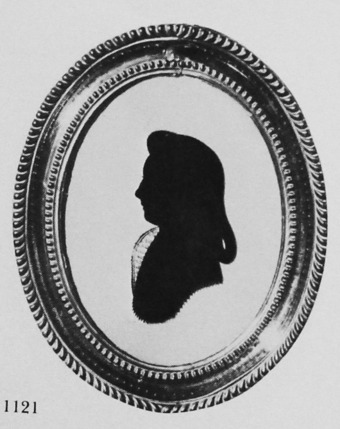
Miss Kitty Berwick
Silhouette painted on flat glass, backed with a second piece of glass coated with gesso
1776
3 ½ x 2 ¾ in./90 x 70mm.
Painted at Newtown, Montgomeryshire.
P. G. Higgs collection

Unknown woman
Silhouette painted on flat glass, backed with a second piece of glass coated with gesso
c. 1784-85
5 x 4in./128 x 102mm.
J. A. Pollak collection

Unknown man
Silhouette painted on flat glass, backed with a second piece of glass coated with gesso
Late 1785 or early 1786
7 x 5in./178 x 128mm.
Frame: oval, giltwood
A silhouette by Jorden of the sitter’s wife is shown in 175.
Mr and Mrs J. H. Gutteridge collection
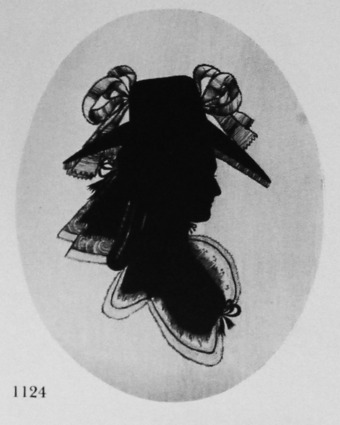
Maria Elisa Cuxon
Silhouette painted on flat glass, originally backed with a second piece of glass coated with gesso
c. 1785
7 x 5in./178 x 128mm.
Taken in Whifnal, where the sitter was born on 2 November 1760. She married Etienne Thibaud, and died at Montpellier in 1 June 1828.
R. B. and S. A. Allen collection
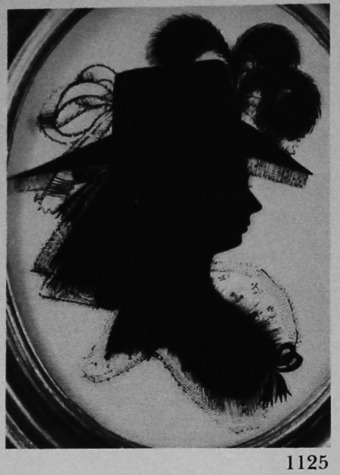
Lady Salusbury, of Cotton Hall, Denbigh
Silhouette painted on flat glass, backed with a second piece of glass coated with gesso
Early 1786
5 ¼ x 4 ½ in./134 x 115mm.
Frame: oval, giltwood
M. A. H. Christie collection
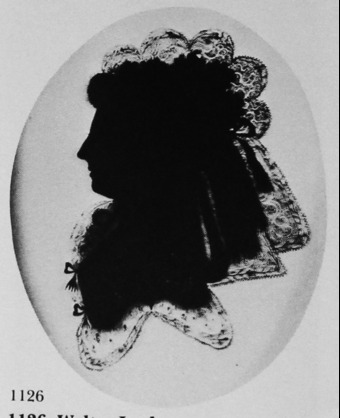
Unknown woman
Silhouette painted on flat glass, backed with a second piece of glass coated with gesso
c. 1786
6 ½ x 5 ½ in./165 x 140mm.
Frame: oval, hammered brass
This silhouette, an example of Jorden’s elaborate later style, bears on the reverse a typed label (added by a former collector) reading ‘by Walter Jorden on Plymouth’.
M. A. H. Christie collection
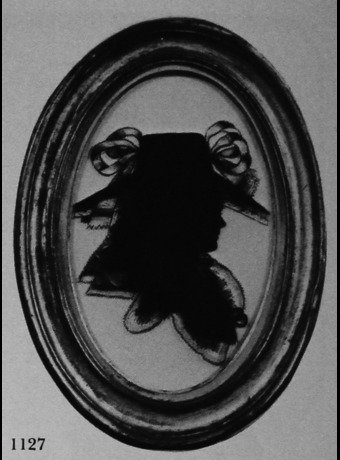
Miss Peninnah Herdsfield, later Mrs Bailey
Silhouette painted on flat glass, backed with a second piece of glass coated with gesso
28 October 1786
7 x 5in./178 x 128mm.
Frame: oval, hammered brass
This silhouette was given to the sitter’s friend Sarah Butterworth on 6 April 1802. The reverse bears the signature ‘W. Jorden’ in faint pencil.
Author’s collection
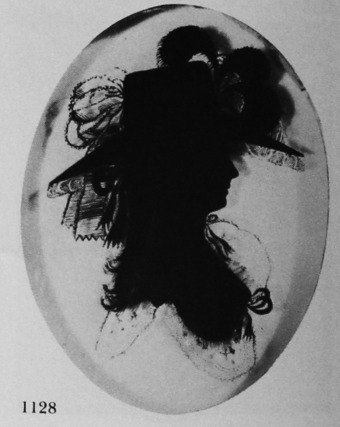
Unknown woman
Silhouette painted on flat glass, backed with a second piece of glass coated with gesso
Late 1786
4 x 3in./102 x 77mm.
Frame: oval, hammered brass
The date is suggested by the sitter’s à la conseilleur hair-style and wide-brimmed hat.
Author’s collection
DETAIL
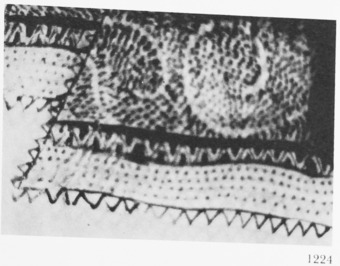
Laces on a woman’s hat.
Detail from a silhouette by Walter Jorden. This fine detail may have been executed with a quill. (1127)
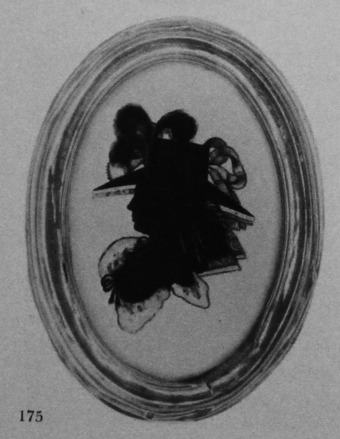
Unknown woman
Silhouette by Walter Jorden, c. 1785-86.
costume dating points
The banging chignon which was in fashion until c. 1786.
The large outdoor hat (adorned with feathers, ribbons and ‘lace curtains0 and worn flat on the head) which was fashionable in the mid-1780s.
The décolletage, finished in front with a ribbon knot. This quirk of fashion was often used by artists to give a finishing touch to the front of a silhouette.
The bow under the chin suggests either a hat cap or a ribbon necklace tied in front.
Mr and Mrs J. H. Gutteridge collection
SECTION THREE
